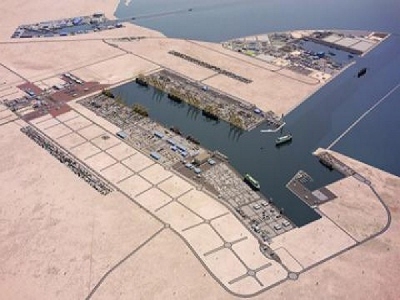
Posted on August 15, 2016
By Turloch Mooney, Fairplay
The first phase of Qatar’s USD7.4 billion Hamad Port is on track to be fully operational by the end of the year as the new facility takes an increasing share of the country’s commercial shipping traffic, relieving congestion at older ports.
A series of tenders and contracts for supply of operational equipment including cranes, forklifts, tractors, and other equipment for the new facility were released by the government in the second quarter. Tender documents for the master plan and design of phase 2 are being released at the moment following a pre-qualification process that started in May.
The port was opened for partial operations at the end of 2015 and is currently handling general cargo and ro-ro vessels shipping vehicles, livestock, and heavy equipment. Data from the ministry of transportation and communications show rapid growth in the number of vessels handled at the new facilities, which in May was more than four times the number handled in April.
Phase 1 will offer 2 million teu of container handling capacity when fully operational, close to triple the current capacity of Doha Port. Phases 2 and 3, will add a further 4 million teu of capacity. The project was originally slated for completion in 2030 but was fast-tracked by the government for early completion and is now due to be fully operational in 2020.
The project is central to Qatar’s efforts to become a global trade and logistics hub and diversify its economy away from reliance on energy resources.
Existing port infrastructure in the country is under strain with congestion and lengthy cargo dwell times commonplace. According to Abdul Aziz Al Yafei, the director of Doha Port, Qatar’s economic boom has resulted in a 69% increase in container volumes and a 380% increase in general cargo over the past five years and port facilities are struggling to handle the growth.
Adding to the challenge of inadequate infrastructure are inefficient cargo handling and clearance processes.
Despite the highest per capital income in world, at place 119 Qatar ranks poorly in the Trading across Borders category of the World Bank’s 2016 Ease of Doing Business survey. Import compliance procedures take an average of 88 hours and cost USD754 per shipment, compared with an average of 9 hours and USD123 among OECD countries. Compliance procedures for export take an average of 30 hours and cost USD382 per shipment compared with 15 hours and USD160 in OECD countries.
A recent initiative to electronically integrate the country’s single window customs clearance system with the Qatar Ports Management network is aimed at reducing time for customs clearance for individual shipments by up to 70% and help speed up the movement of goods through port areas.
In addition to container facilities, the Hamad Port will have capacity to handle 1.7 million tonnes of general cargo, 1 million tonnes of grain, and about 500,000 vehicles per year. A coastguard station, marine support unit, facilities for fabrication and maintenance of offshore and land-based petrochemical structures, and a major ship repair hub are included in the development plans. The port will also serve as a centre for Qatar’s maritime security with a new offshore base for the Qatar Emiri Naval Forces.
A special economic zone adjacent to the port, the Qatar Economic Zone 3 (QEZ3), is being developed with the objective of becoming the shipping and trade gateway to Qatar and an economic hub for manufacturing, logistics, and trade across a number of industrial sectors.
Source: Fairplay





